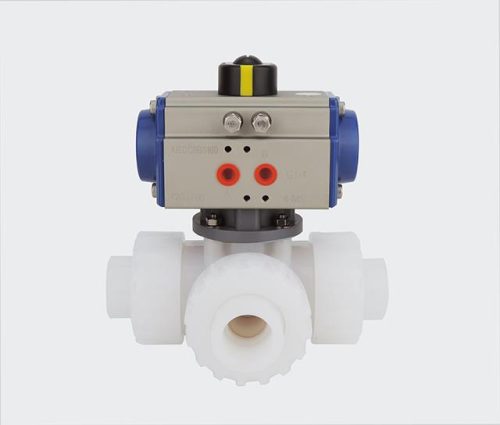PVDF ball valves play a critical role in chemical processing industries, standing out for their exceptional chemical resistance, durability, and ability to perform under high temperatures and pressures. Unlike other plastic valve options, such as PVC ball valves, CPVC ball valves, and general plastic ball valves. PVDF valves are specifically designed to handle harsh environments where safety and reliability are paramount. This blog explores the unique properties of PVDF as a material, key applications in industries like petrochemicals and wastewater treatment, and the advantages they bring to system performance. By understanding how PVDF ball valves complement other plastic valve solutions, you can optimize your operations with the right combination for every application. Discover why PVDF valves are a top choice for maintaining efficiency, compliance, and long-term cost-effectiveness in demanding chemical processes.
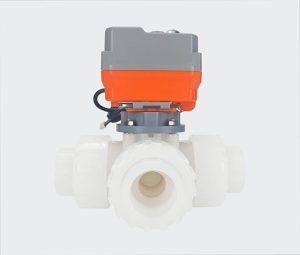
Introduction
Valves are indispensable components in industrial operations, playing a pivotal role in regulating the flow, pressure, and direction of fluids, gases, and other materials within complex systems. These devices ensure precise control and seamless transitions. Which are critical for optimizing process efficiency, maintaining safety standards, and preventing costly disruptions. In industries such as chemical processing, valves handle the movement of corrosive chemicals under demanding conditions, while in the oil and gas sector, they manage the high-pressure transport of hydrocarbons.
Similarly, water treatment facilities rely on valves to distribute and isolate water during filtration and purification processes, ensuring uninterrupted operation. The manufacturing sector, too, depends on valves to control a wide array of substances, from cooling liquids to pressurized air systems, ensuring smooth production workflows. By integrating advanced materials and designs tailored to specific applications, valves not only enhance system reliability but also contribute to greater energy efficiency and compliance with environmental standards.
PVDF (Polyvinylidene Fluoride) ball valves are widely recognized as a superior solution for the stringent demands of chemical processing industries. Engineered from a highly durable fluoropolymer, these valves offer exceptional resistance to a broad range of aggressive chemicals, including acids, bases, and organic solvents, making them ideal for environments where standard materials fail. Their impressive thermal stability and ability to perform under high pressure allow PVDF ball valves to maintain their structural integrity and operational efficiency even in extreme conditions.
Section 1: Understanding PVDF Ball Valves
Polyvinylidene Fluoride (PVDF) is a high-performance thermoplastic fluoropolymer known for its remarkable combination of properties. Making it an indispensable material in various industrial applications. One of its most notable characteristics is its exceptional chemical resistance, as it can withstand prolonged exposure to acids, bases, strong oxidizers, and organic solvents without degrading or losing performance. Additionally, PVDF offers high thermal stability. Allowing it to tolerate extreme temperatures without compromising its mechanical properties. Which is crucial in industries that operate under intense heat or fluctuating conditions. This material also exhibits excellent mechanical strength and abrasion resistance, ensuring durability in demanding environments.
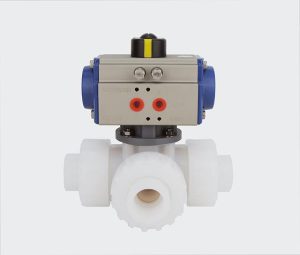
PVDF ball valves are meticulously crafted to deliver superior performance in demanding industrial environments. The construction centers around three primary components: the ball, the body, and the seals, each pivotal to the valve’s functionality and reliability. The ball, often precision-engineered with a smooth, non-porous surface, is designed to pivot seamlessly within the body, controlling flow with precision and ensuring minimal wear over time. The body, made entirely from PVDF material, provides a robust yet lightweight structure that resists corrosion and degradation, even in contact with highly aggressive chemicals or under high-temperature conditions. Seals, typically crafted from high-performance elastomers, are integrated to create a leak-proof closure, further enhancing the valve’s operational safety and efficiency.
The design also incorporates features such as ergonomic handles or actuators for effortless operation and alignment with industrial automation systems. PVDF ball valves are known for their modular design. Enabling straightforward installation, maintenance, and replacement of components. This thoughtful construction not only ensures reliable chemical resistance and long service life but also simplifies the management of critical flow processes in chemical processing, water treatment, and other industrial applications.
Section 2: Applications in the Chemical Processing Industry
Explore specific use
PVDF ball valves are highly valued for their exceptional performance in handling aggressive substances such as acids, solvents, and bases. Making them indispensable in various industrial applications. In chemical processing, these valves are used to manage corrosive fluids like hydrochloric acid and sulfuric acid. Where their unmatched resistance ensures operational safety and longevity. Similarly, in the pharmaceutical industry, PVDF ball valves are essential for maintaining the purity of delicate solutions and preventing chemical reactions that could compromise product integrity. When dealing with solvents used in manufacturing or cleaning processes, these valves maintain a leak-proof seal, ensuring environmental and workplace safety while withstanding prolonged chemical exposure.
Water treatment facilities also benefit from their durability and ability to resist degradation when exposed to chlorine, alkalis, and other reactive substances used in purification processes. The non-reactive nature of PVDF minimizes contamination risks. While its resistance to high temperatures and pressures ensures consistent reliability even under extreme operating conditions. Across these applications, PVDF ball valves stand out for their dependability, contributing to efficiency, compliance with stringent regulations, and reduced maintenance in demanding industrial environments.
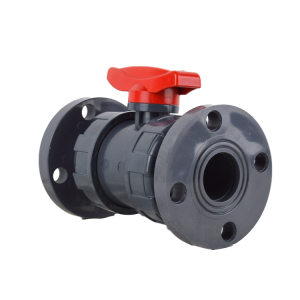
Discuss their ability to maintain operational integrity
PVDF ball valves are engineered to excel in environments with high pressure and temperature, maintaining operational integrity where others may falter. The inherent thermal stability of PVDF allows these valves to withstand significant temperature fluctuations without losing their structural integrity or mechanical performance. This is complemented by their impressive mechanical strength, which resists deformation, warping, or cracking under elevated pressures. Ensuring continuous operation even in the harshest conditions.
Unlike many materials, PVDF does not become brittle or compromise its resistance to wear over time when exposed to prolonged stress, an essential characteristic for critical industrial applications. These valves are also designed to provide a consistent seal, preventing leaks or failures that could disrupt operations or pose safety risks. Their ability to endure extreme conditions makes PVDF ball valves a preferred choice for industries such as chemical processing. Where they handle volatile or reactive substances, and power generation, where high-pressure steam is a factor. Ultimately, their robust construction and resilience translate into greater reliability, operational efficiency, and peace of mind in safety-critical industrial systems.
Section 3: Advantages of Using PVDF Ball Valves
Breakdown of key benefits
PVDF ball valves offer a comprehensive range of benefits that make them a benchmark in industrial valve technology, particularly for demanding applications. Their exceptional chemical resistance is a standout feature. Providing unparalleled protection against corrosive substances such as strong acids, alkalis, and solvents. This ensures consistent performance even in the harshest chemical environments. Minimizing the risk of material degradation and extending service life. Durability is another defining advantage, as PVDF’s robust nature resists mechanical wear, thermal stress, and pressure fluctuations, allowing these valves to maintain structural integrity over prolonged operational periods. This resilience not only enhances safety in critical systems but also reduces the frequency of replacements and repairs.
Additionally, PVDF ball valves are design with low-maintenance operation in mind. Their smooth, non-porous surface minimizes the build-up of deposits. While their precise construction ensures leak-proof performance, even under continuous use. These characteristics translate into reduced operational downtime and lower overall maintenance costs. Making them a cost-effective solution for industries such as chemical processing, water treatment, and pharmaceuticals. By combining chemical resistance, durability, and ease of maintenance, PVDF ball valves deliver reliability, efficiency, and value, meeting the rigorous demands of modern industrial systems.
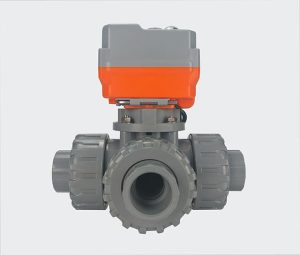
Discuss cost-effectiveness
PVDF ball valves demonstrate exceptional cost-effectiveness in the long term. Making them a superior choice compared to both metal valves and lower-grade plastic alternatives. While the initial investment in PVDF valves may be higher, their significantly longer lifespan and ability to maintain consistent performance under extreme conditions more than offset the upfront costs. Unlike metal valves, which can succumb to corrosion in aggressive chemical environments. PVDF valves offer unmatched resistance to acids, solvents, and alkalis, drastically reducing the need for replacement and repair. Similarly, unlike lower-grade plastic valves that may degrade under high pressures or temperatures. PVDF valves retain their structural integrity, ensuring reliability in demanding applications.
Additionally, their design for low-maintenance operation. Including features that prevent leaks and minimize scaling or build-up, further reduces operational downtime and ongoing service expenses. These factors combine to lower the total cost of ownership. Making PVDF ball valves not only a durable and high-performing solution but also a financially prudent choice for industries. Such as chemical processing, water treatment, and pharmaceuticals. By investing in PVDF ball valves, businesses can achieve long-term operational efficiency and significant savings over time.
Section 4: How PVDF Ball Valves Complement Other Plastic Valves
PVDF ball valves are often utilize in conjunction with PVC, CPVC, and other plastic valve types to create highly efficient and adaptable fluid management systems across diverse industrial applications. Each type of valve brings distinct properties suited to specific functions, allowing systems to be tailored to operational demands. PVDF ball valve, with their exceptional chemical resistance and thermal stability, are frequently chosen for critical processes involving corrosive acids, solvents, and high temperatures.
Meanwhile, PVC ball valves, known for their affordability and corrosion resistance, are ideal for handling low-pressure water flow in applications like irrigation or general-purpose fluid transfer. CPVC valves, offering enhanced temperature tolerance compared to PVC, bridge the gap by excelling in systems that require moderate heat resistance. Such as hot water distribution and chemical handling. When integrated into a single system, these valves work together to optimize cost-effectiveness, durability, and performance reliability.
For example, PVC and CPVC valves might manage less aggressive flow paths. While PVDF valves handle extreme conditions, ensuring the entire setup operates efficiently without over-specifying materials where they aren’t needed. This strategic use of complementary valve types allows industries such as chemical processing, water treatment, and power generation to maximize operational efficiency and extend the lifespan of their systems. All while maintaining safety and regulatory compliance.
Section 5: Factors to Consider When Choosing a Plastic Valve
When selecting PVDF ball valves for industrial applications, understanding key considerations such as chemical compatibility, temperature and pressure ratings. And required certifications is crucial to ensuring system safety and efficiency. Chemical compatibility is a primary factor. As PVDF valves are often deploy in environments involving aggressive substances like acids, solvents, and alkaline solutions. Carefully matching the valve material to the chemicals in use reduces the risk of degradation, contamination, or leaks. Safeguarding both the process and operational longevity. Temperature and pressure ratings are equally important, as industrial settings frequently impose extreme operating conditions. PVDF valves are prize for their ability to withstand elevated temperatures and maintain structural integrity under high pressure. But it is critical to validate these properties against specific system requirements to prevent premature failure or compromise in performance.
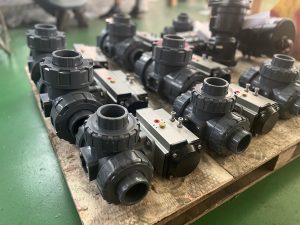
Finally, adherence to required certifications. Such as FDA compliance for food and pharmaceutical applications or ANSI/ASME standards for industrial safety, is non-negotiable. These certifications confirm that the valves meet stringent quality, safety, and performance criteria. Ensuring compliance with industry regulations and minimizing operational risks. By thoroughly addressing these considerations, businesses can leverage the superior qualities of PVDF ball valves to achieve reliable, efficient, and regulation-compliant fluid control systems across diverse applications.
FAQs
1. What sizes are available for PVDF ball valves?
PVDF ball valves are available in a range of sizes, typically starting from 1/2 inch (DN15) up to 4 inches (DN100). Custom sizing may be available depending on the manufacturer.
2. Where are PVDF ball valves typically used?
These valves are commonly utilised in industries such as:
Chemical Processing
Water Treatment Plants
Pharmaceutical Manufacturing
Oil & Gas Applications
Semiconductor Fabrication
3. How do you maintain a PVDF ball valve?
Maintenance is minimal with PVDF ball valves as their non-reactive surface prevents scaling and corrosion. However, regular inspections for wear, leakage, and proper operation are recommend to ensure optimal performance over time.
4. Are PVDF ball valves suitable for high-pressure systems?
Yes, PVDF ball valves are design to handle moderate to high-pressure systems, with pressure ratings typically varying between 10 and 16 bar depending on the valve’s design and size.
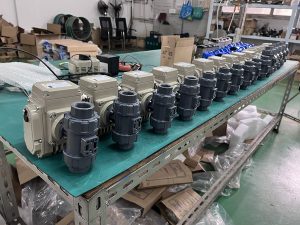
Conclusion
PVDF ball valves are indispensable components in the chemical processing industries. Where safety, reliability, and efficiency are critical to daily operations. Their exceptional chemical resistance ensures they can withstand highly aggressive substances, from acids to solvents. Without compromising structural integrity or contaminating processes. Combined with their remarkable durability and resistance to high temperatures and pressures. These valves are perfectly suit for managing demanding applications in harsh environments.
Furthermore, their low-maintenance operation and extended service life result in significant cost savings over time. Reinforcing their status as a cost-effective solution for complex fluid control systems. Beyond performance, PVDF ball valve adhere to stringent industry certifications, ensuring compliance with regulatory standards and bolstering operational safety. By delivering unparalleled reliability and efficiency while minimizing long-term operational costs. PVDF ball valve play a critical role in transforming the chemical processing industries. Enabling businesses to meet exacting demands while maintaining sustainable and secure operations.

